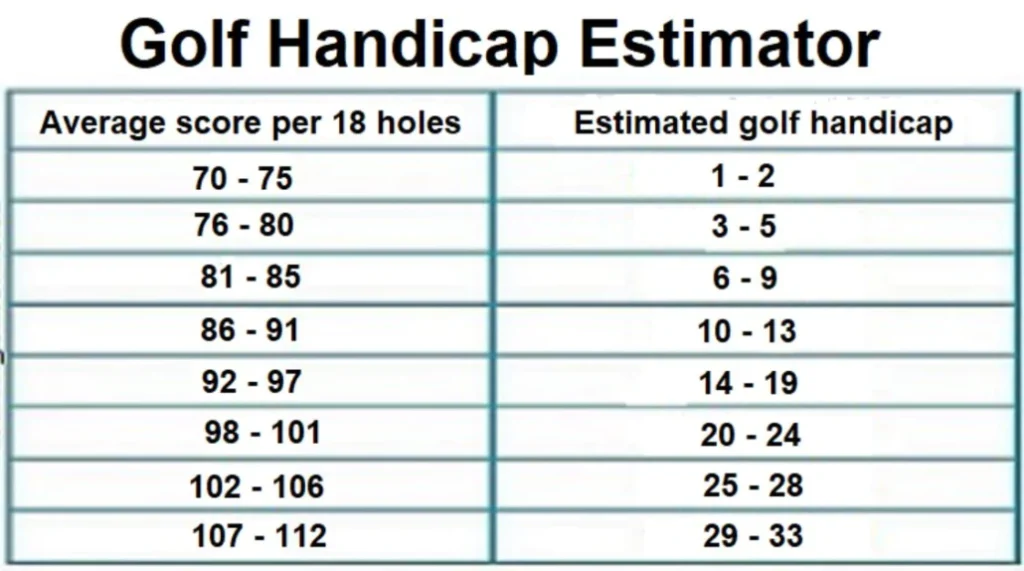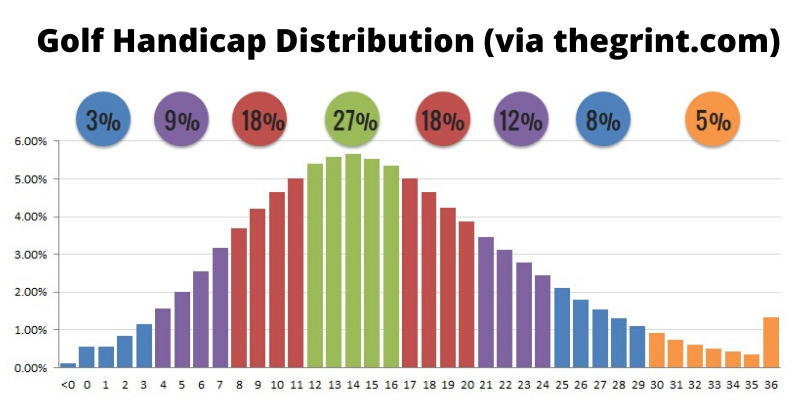How to calculate a golf handicap
Key Takeaway:
- A golf handicap is a numerical measure of a golfer’s playing ability, used to level the playing field in competitive matches.
- Calculating a Handicap Index is important for golfers as it helps determine a fair and equitable match against opponents of varying skill levels.
- To calculate the Handicap Index, golfers need to input a minimum number of scores, select and average the best scores, and apply adjustments and safeguards to ensure accuracy.
Introduction
Discover the world of calculating a golf handicap with this informative article. Get ready to dive into the MECE Principle and gain a better understanding of its significance in determining golf handicaps. Uncover the essence of this strategic approach and explore its practical applications within the realm of golf. With a focus on accuracy and fairness, the MECE Principle serves as a vital tool for golfers seeking to establish their handicap with precision.
Brief explanation of the MECE Principle
MECE stands for Mutually Exclusive and Collectively Exhaustive. It is a framework used in problem-solving and analysis. It ensures that all options and pieces of info are distinct and not duplicated. It also ensures that no relevant info or solution is left out. It helps to avoid biases, identify gaps, and present info logically.
In short, MECE is a great tool for problem-solving and analysis. It allows for a comprehensive exploration of all possibilities. By following this framework, decisions are made based on complete and organized info.
Understanding Golf Handicap
Golf handicaps play a crucial role in leveling the playing field for golfers of different skill levels. In this section, we will delve into the importance and purpose of having a golf handicap, and how it affects the game. We’ll explore the range of handicaps available for both men and women, shedding some light on how this system ensures fair competition. Get ready to gain a deeper understanding of golf handicaps and how they enhance the sport!
Explanation of what a golf handicap is
A golf handicap is a numerical measure of your ability compared to the difficulty of a golf course. It helps level the playing field, so players of any skill level can compete.

To calculate it, various factors are taken into account. Scores from previous rounds, the course’s difficulty rating, and performance adjustments are all considered. This ensures the handicap accurately reflects your ability.
A minimum number of scores is needed to calculate the index. This prevents manipulation and abuse. The final handicap index is calculated by averaging the best scores.
The course handicap takes into account course rating, par, and slope rating. This allows players to adjust their scores based on the course’s difficulty.
Tools like online calculators and mobile apps are available to calculate handicaps. They give accurate results, saving time.
To improve your handicap, practice regularly. Check your equipment and play different courses. Instructional videos and lessons can help too.
The World Handicap System has standardized and improved handicap calculations worldwide. It makes the process more accurate and reflective of a player’s ability.
Focus on consistent practice to improve your handicap. Get feedback from a professional instructor for guidance.
Remember: a golf handicap is the only thing that makes us feel good about being bad at golf.
Purpose of a golf handicap in the game
A golf handicap is all about fairness. It allows players of different skills to compete on an equal basis. It adjusts scores so everyone has a competitive chance. It also tracks progress over time. This encourages friendly competition and inclusivity.
Even the worst golfer can feel like a pro, and the best golfer can feel like a beginner. All in all, golf handicaps promote fairness, competition, progress, and participation.

Range of handicaps for men and women
Golfers’ handicaps for men and women range differently. This range offers an even playing field and a fair competition between players of all skill levels.
Look at this table to gain insight into the range of handicaps for men and women based on their Handicap Index:
| Handicap Index Range | Men | Women |
|---|---|---|
| 0 – 5 | Scratch | Scratch |
| 6 – 12 | Single Digit | Single Digit |
| 13 – 20 | Mid Handicapper | Mid Handicapper |
| 21 – 28 | High Handicapper | High Handicapper |
| 29+ | Beginner/Novice | Beginner/Novice |
The table classifies golfers according to their Handicap Index range. This way, players with similar skill levels can compete against each other.
It’s important to remember that this table is just a general guideline. Individual clubs or associations may have different handicap ranges. These ranges may be affected by factors such as course difficulty, gender-specific considerations, or regional rules.
Knowing these handicap ranges helps golfers rate their own skill level and choose suitable opponents. This way, they can make good decisions about participating in competitions.
Calculating the Handicap Index
Calculating your Handicap Index is essential for every golfer, offering valuable insights into your skill level and allowing for fair competition. In this section, we will explore the importance of having a Handicap Index and delve into the process of calculating it.
We’ll also touch upon the minimum number of scores required, the selection and averaging of the best scores, as well as the adjustments and safeguards in place. So, let’s dive into the world of handicapping and unlock a fairer playing field in golf.
Importance of having a Handicap Index
A Handicap Index is essential in golf. It’s a standardized measure of a player’s skill level. This Index calculates an average score from previous rounds. It helps players compete on an equal footing, no matter their skill level.
Knowing one’s handicap is important. It allows golfers to set goals and track progress. It provides a benchmark to evaluate strengths and weaknesses.
The Index also helps promote fair play. It adjusts higher skill levels to even the odds when golfers compete.
Math can be fun with Handicap Index calculations! Be a pro golfer with this key to success.
Process of calculating the Handicap Index
- Select Best Scores: Choose scores that show your current skill level.
- Average Scores: Calculate the average to get the Handicap Differential. This takes into account any course difficulty differences.
- Adjustments & Safeguards: These help stop manipulation, factoring in abnormal scores and other variables.
- Calculate Handicap Differential: Do this with the formula given, or use online/app calculators.
- Determine Handicap Index: Use the best scores to qualify for the index.
- Receive Handicap Certificate: You’ll get your officially calculated Handicap Index. This shows your skill level relative to others.
Note: Variations may be needed depending on the handicap system. Calculating a golf handicap accurately helps enhance the experience. It allows players of different skill levels to compete fairly. Use online calculators and apps to get reliable calculations. This helps golfers focus on improving their skills and enjoying the game.
Minimum number of scores required for calculation
- The minimum number of scores for handicap calculation is necessary for accuracy. To do this, follow these steps:
- Gather at least 5, but preferably more, valid scorecards from rated courses.
- Meet the minimum requirements (Rules of Golf, hole-by-hole info).
- Select applicable scores based on factors (course rating, data, timeframes).
- Use the formula provided by the handicap authority.
- Five scores is the minimum, but more are often used for a better evaluation. Technology has made this process simpler with calculators and mobile apps for instant calculations and automated adjustments.
- The concept of handicapping dates back to the early days of golf, and has evolved to standardized systems like the World Handicap System. With the right tools, golfers can assess their skill level and compete equitably.
Selecting and averaging the best scores
Professional golfers calculate their handicap index by selecting and averaging the best scores. This process involves choosing rounds that accurately reflect their skill level. They select the scores considering factors such as course difficulty, weather, and performance.
Scorecards or digital apps are used to input scores and calculate the average. The World Handicap System requires 54 holes worth of scores to establish a handicap index. This ensures an adequate sample size.
By selecting the best scores, golfers can account for variations in performance and eliminate outliers that don’t represent their skill level. This provides a fair assessment of a golfer’s ability by focusing on consistent performances.
Adjustments and safeguards in place
Adjustments and safeguards are in place to guarantee accuracy and equity in the golf handicap system. These measures are used to sustain the system’s integrity and offer a balanced playing field for all golfers.
- Adjustments for irregular scores: To stop extraordinary or outlier scores from impacting a golfer’s handicap drastically, corrections are made. This assists in accounting for any superior performances or poor rounds that may not precisely indicate a player’s overall skill.
- Safeguards versus sandbagging: Sandbagging refers to a deliberate adjustment of scores to get a lower handicap than deserved. To avoid this, the handicap calculation procedure includes controls that identify and impede such behavior. This involves reviewing a player’s scoring history and adjusting their handicap if suspect patterns are noticed.
- Peer review and confirmation: Golf handicaps can be self-reported, yet they are often checked by peers to guarantee accuracy. Other players in the same club or league may inspect scorecards and give input on whether the reported scores look consistent with the player’s capability.
- Regular updates and corrections: The golf handicap system is regularly examined and updated to mirror changes in the game, technology, course conditions, and scoring trends. This makes certain that the system remains applicable, fair, and reflective of a golfer’s present abilities.
These adjustments and safeguards are significant for keeping fairness in the golf handicap system by preventing abuse, promoting accuracy, and evening the playing field for all participants.
As well, it is worth noting that these measures are subject to regular revisions as part of continuing attempts to enhance the golf handicap system. By staying up-to-date with these adjustments, golfers can be assured of their computed handicaps as they struggle to enhance their game.
Calculating a Course Handicap is like tackling a complex puzzle. Instead of a picture, you get a number that decides your golf destiny.
Calculating a Course Handicap
Calculating a Course Handicap is an essential part of understanding your performance in golf. In this section, we will explore the purpose of a Course Handicap and the various factors involved in its calculation. We’ll dive into important components like Slope Rating, Course Rating, and Par, shedding light on how they impact your handicap. Get ready to unlock the formula for calculating your Course Handicap and gain valuable insights into your game.
Purpose of a Course Handicap
A Course Handicap serves to level the playing field in golf. It adjusts a player’s Handicap Index based on the course difficulty. This allows players of different abilities to compete fairly and to perform their best.
Factors like Slope Rating, Course Rating, and Par are taken into account. The Slope Rating shows how hard the course is for bogey golfers compared to scratch golfers. The Course Rating represents difficulty for a scratch golfer. With Par, which is the number of strokes an expert should take to finish a hole or round, the Course Handicap is calculated.
Each course has its own formula due to varying factors such as length, hazards, and difficulty. This penalizes or rewards players based on their performance relative to the course.
The World Handicap System is used to create fairness across golf courses worldwide. By standardizing handicap calculations, players from any country or region can compete fairly.
Factors involved in calculating a Course Handicap
A golf course handicap is worked out using several factors. These allow players of different levels to compete fairly. One factor is the slope rating. This measures the difficulty for a bogey golfer compared to a scratch golfer.
A higher rating means a harder course. Another factor is the course rating. This is the expected score for a scratch golfer. Par is the number of strokes an expert golfer should take to complete each hole. This, along with other factors, help to calculate a course handicap accurately. This means players can compete on equal footing.
The history of golf handicaps goes back a long way. As early as 18th-century Scotland, golfers used methods to level the playing field. Now, the World Handicap System (WHS) provides an even platform for golfers. WHS takes various factors into account to ensure accurate handicaps. This helps with reliable competition and enjoyable gameplay.
So, Slope Rating, Course Rating, and Par – these are the maths that make your high school algebra teacher proud!
Slope Rating, Course Rating, and Par
Let’s delve deeper into these factors through a table:
| Slope Rating | Course Rating | Par |
| This number indicates how hard a course is for bogey golfers compared to scratch golfers. It takes into account length and obstacles. | The score a scratch golfer is expected to achieve under normal conditions. | Number of strokes it should take a scratch golfer to complete each hole. |
These terms are important in calculating a golfer’s handicap. Also, slopes determine difficulty and women may have different ratings based on their teeing grounds.
To improve your handicap: practice regularly, conduct equipment checks, and play different courses. This gives you the chance to face various challenges and grow as a golfer.
Grasping the significance of Slope Rating, Course Rating and Par helps calculate your handicap accurately. With the right tools and resources, you can navigate this system to ensure fairness among golfers.
Formula for calculating the Course Handicap
Calculating your Course Handicap is a must for playing golf! It takes into account Slope Rating, Course Rating, and Par. Here’s a 5-step guide to figuring it out:
- Determine Slope Rating: Find the Slope Rating of the course. This tells how hard the course is for a bogey golfer compared to a scratch golfer. You can find it on a scorecard or ask the golf club or handicap organization.
- Find Course Rating: For both men and women, find the Course Rating. This is the expected score for a scratch golfer on that course. Distance, hazards, and difficulty are taken into account.
- Determine Par: Par is the number of strokes an expert golfer should take for each hole. It’s usually on the scorecard or available from reliable sources.
- Use the Formula: With Slope Rating, Course Rating, and Par known, use the formula to calculate Course Handicap:
(Handicap Index) x (Slope Rating) / 113. - Adjust if Needed: Golf organizations or clubs may have rules or regulations, like Local Rules or adjustments for tournament scores, that need to be considered. Check with the relevant organization to make sure you’re using the most accurate formula.
Knowing how to calculate your Course Handicap is a must for golfers who want to compete or assess their performance. With these factors in mind, players can adjust their handicaps and make the playing field fair. Calculating your golf handicap? Easier than finding a lost ball in a water hazard!
Tools and Resources for Calculating Golf Handicap
Discover the tools and resources that make calculating your golf handicap a breeze. From handy calculators and apps to ensure accuracy in your calculations, to the benefits they bring to your game, we’ve got you covered. Say goodbye to manual calculations and hello to an easier way to track and improve your golf handicap.
Availability of golf handicap calculators and apps
Golfers can use handy handicap calculators and apps to accurately calculate their handicap index. They offer quick calculations based on golfer’s scores.
These tools are available on various devices like smartphones, tablets or computers. There is a wide range of calculators and apps, each with its own features.
For example, some have course databases, score tracking and statistical analysis.
This saves time and eliminates the need for manual calculations.
Golfers gain more control over their progress and can make informed decisions about areas of improvement.
These calculators and apps give them the knowledge they need to understand their skill level and develop their game.
By using these tools, golfers can confidently navigate the complex world of handicaps.
Benefits of using these tools for accurate calculations
Tools for accurate golf handicapping calculations bring many benefits. These tools, such as calculators and apps, make it easy to work out a golfer’s handicap index and course handicap.
Firstly, these tools are accurate. They get rid of human mistakes and give dependable results based on formulas and algorithms.
Also, they save time. Players just enter data and voila! Calculations done in a jiffy, so more time can be spent playing.
On top of that, these tools track progress. Features like score recording, analysis of trends, and seeing improvements in handicaps over time come in handy.
Furthermore, these tools provide data about courses and competitions. For example, details like par, course rating, and slope rating can be found.
Lastly, these tools level the playing field. By making sure handicaps are accurately calculated, golfers can compete fairly.
In conclusion, tools for accurate golf handicapping calculations give multiple advantages. Their accuracy, time-saving, tracking, data-providing, and fairness-promoting features make them invaluable. Golfers can use these tools to make informed decisions and be sure their handicap is being shown correctly in their game.
Improving Golf Handicap
Looking to improve your golf handicap? In this section, we’ll dive into valuable tips, techniques, and the importance of practice to help you shave off those extra strokes. We’ll also explore the significance of equipment checks and the benefits of playing on different courses.
And if you’re hungry for more resources to up your game, we’ve got you covered. Let’s get your handicap headed in the right direction!
Tips and techniques for improving golf handicap
To reduce your golf handicap, strategic techniques and tips must be used. Applying these tips and techniques can help you lower your handicap and improve your performance on the course.
To develop a consistent swing, regular practice and working with a golf instructor is key. This can increase accuracy and control.
Creating practice routines that target areas such as putting, chipping, or driving is also essential. This can help you see progress and lower your handicap.
Playing different courses is a great way to improve. They provide unique challenges and can give you new strategies. This makes you a more versatile player.
To further enhance your game, watch instructional videos, read books on golf strategy, and use training aids designed for specific aspects of the game. These resources offer valuable insights and techniques that can be applied.
By continually seeking improvement and using available tools, you can steadily enhance your skills, reduce your handicap, and enjoy a more rewarding experience on the golf course.
Importance of practice, equipment check, and playing different courses
Practicing and equipment checks are key for golf handicap improvement. Regular practice lets golfers refine skills, improve swing technique and become more consistent in their game. Through practice, they can spot and fix areas that need work, leading to better performance on the course.
Equipment check is essential. Maintaining and regularly inspecting gear ensures optimal functioning and performance. Clubs must be properly fitted, grips should not be worn down, and balls must be in good condition.
Playing various courses also helps. Golfers gain exposure to different layouts, conditions, and challenges. This lets them adapt their game strategy, make wiser decisions on the course, and improve their handicap.
Additional resources for golf improvement
To improve your golf handicap, there are extra resources to use. They help to boost your skills, techniques, and strategies, leading to better gameplay.
- Video Tutorials: On the web, you can find many videos with golf guidance. They show mechanics of the swing, putting tactics, and course management.
- Golf Books: Experts and professionals have written books about golf improvement. They have tips and strategies which you can use on the course.
- Golf Clinics and Lessons: You can get help from a pro. They can break down your strengths and weaknesses and provide instruction for each golfer.
- Golf Training Aids: There are tools to help you remember your swing, align yourself, and become a better player. These tools include alignment tools, putting trainers, and swing trainers.
On online forums, you can speak to other golfers and get advice and suggestions.
To reduce your handicap, you need to practice and be dedicated. Play different courses, check your equipment, and keep on learning. Use video tutorials, books, and other resources. Enjoy the improvement process!
In golf, numbers can be unpredictable, like your swing. But, the handicap system has evolved over time.
Evolution of Golf Handicap System
The evolution of the golf handicap system has transformed the way players calculate and compare their skill levels. In this section, we’ll dive into a brief history of the golf handicap system, the introduction of the World Handicap System, and the significant changes in the handicap calculation process. Get ready to explore how these advancements have made the game more fair, equitable, and enjoyable for golfers of all levels.
Brief history of the golf handicap system
Golfers used to compete without a way to measure their skill levels. Therefore, fairness in competitions was lacking and players of different abilities couldn’t compete on equal footing. To fix this, the handicapping system was created. This system assigns a numerical representation of a golfer’s skill level, known as a handicap index. It is based on scores achieved in golf rounds.
Calculating the index has changed over time. Initially, averages of scores had to be submitted. Adjustments and safeguards were put in place to make sure it was accurate. Technology has made it easier to calculate the index. There are now online calculators and mobile apps for golfers to use.
The World Handicap System was introduced to streamline and standardize the calculation process. This system brings together handicapping organizations from around the world under one unified set of rules. Everyone can now feel like Tiger Woods, even if they play like Happy Gilmore!
World Handicap System and its benefits
The World Handicap System is revolutionizing golf handicapping! It brings together different national systems and creates one unified framework. This means players can now have their handicap index calculated using the same formula no matter where they play or their nationality. It’s all about fairness and consistency!
The World Handicap System helps provide an accurate representation of a player’s skill level. It factors in recent scores from different courses. Plus, it adjusts for course difficulty through the use of slope rating and course rating. This leads to a reliable handicap index that reflects a golfer’s performance abilities.
This system also encourages more participation and engagement in the game. Golfers can compare their skills to others around the world and track progress over time. This creates a sense of community and healthy competition.
Overall, there are many benefits of the World Handicap System. Fairer competitions, skill comparison among players internationally, and increased participation in the sport! Familiarize yourself with the guidelines to make the most of it!
Changes in the handicap calculation process
Evolution of the golf handicap system has seen changes in the calculations. The World Handicap System has brought significant alterations to handicap calculation. This new system aims to give a consistent and reliable way to calculate a golfer’s handicap.
A change includes an average score differential in the formula. This considers a player’s potential scoring ability. It uses a statistical model with their best scores over time. This average score differential makes sure a golfer’s handicap reflects their skill level.
Another change is using both Course Rating and Slope Rating. They represent the difficulty of a course for scratch and higher handicappers. By using these ratings, golfers can have an adjusted handicap that considers the challenge of a course for them.
These changes create an equitable playing field. They make sure golf handicaps are calculated fairly and consistently. This allows players with different skills to compete on an equal footing.
Conclusion
Understanding and calculating a golf handicap is crucial for leveling the playing field. In this concluding section, we will recap the importance of this knowledge, encourage the use of available tools and resources for accurate calculations, and highlight how a golf handicap can positively impact the fairness and competitiveness of the game. So, let’s dive in and discover why mastering your golf handicap is essential for an enriched golfing experience.
Recap of the importance of understanding and calculating a golf handicap
Golf handicaps are key for fair competition. They let players of different skill levels compete on the same playing field. Handicaps help set realistic goals and measure progress.
A handicap reflects a player’s potential, not average performance. It takes the course difficulty into consideration and enables fair comparisons between players with various abilities. Even those with higher handicaps can compete against more skilled players.
Calculating a golf handicap requires several factors. These include a Handicap Index and Course Handicap. The Handicap Index shows a player’s potential ability. The Course Handicap adjusts this index for the specific course. Accurate data is essential for reflecting a player’s true skill level.
The world handicap system has evolved. Technology such as golf handicap calculators and apps make it easy to calculate handicaps. Get your calculations up to par with the pros!
Encouragement to use available tools and resources for accurate calculations
Using tools and resources to calculate golf handicaps accurately is a must for players aiming to measure their skill level precisely. Utilizing these resources, such as golf handicap calculators and apps, guarantees that Handicap Index and Course Handicap are calculated properly.
- Golf handicap calculators and apps give players an easy way to calculate and monitor handicaps without manual complex calculations.
- These tools offer extensive features which consider the Slope Rating, Course Rating, Par and other adjustments for precise calculations.
- Using these tools also avoids human error, making sure the results are dependable and consistent.
- Also, these resources provide helpful insights into areas of improvement by studying scores over time and observing trends or patterns in a player’s performance.
In addition, it’s important to remember that having an exact golf handicap not only provides an impartial assessment of a player’s ability but also ensures fair competition among players with diverse skill levels. This equalizes the playing field, inspiring healthy competition and increasing the total pleasure of the game.
Furthermore, it’s worth noting that the World Handicap System has changed over time to better accuracy and equity in calculating handicaps. The application of aspects such as Course Rating and Slope Rating has made a major contribution to more exact handicap calculations. Players who take advantage of those tools and resources can get the most out of these improvements in the system.
Golf.com confirms that the availability of online golf handicap calculators has made it easier than ever for players to calculate their handicap accurately.
Significance of a golf handicap in leveling the playing field
Golf handicaps are important for equalizing the playing field for golfers of different abilities. They provide a way to measure and compare performance, enabling players to compete on an equal footing. This promotes fairness and ensures that skill, not talent or experience, determines the outcome.
Handicaps consider course difficulty and adjust a player’s score accordingly. This allows individuals of varied skill levels to compete against one another in a meaningful way.
Furthermore, handicaps also foster motivation and give golfers a sense of accomplishment. They can set goals based on their handicap index and work towards lowering it over time. This provides a positive attitude and pushes them to improve, resulting in growth as golfers.
Pro Tip: When calculating a golf handicap, input scores accurately and update the handicap index regularly. This will give an accurate assessment of skill and ensure fair competition.
Some Facts About How To Calculate a Golf Handicap:
- ✅ A golf handicap reflects a player’s skill level based on their score compared to the course’s par. (Source: golfworkoutprogram.com)
- ✅ The Handicap Index is calculated using a player’s 18-hole scores. (Source: usga.org)
- ✅ The Handicap Index is determined by averaging the best 8 Score Differentials from the most recent 20 scores. (Source: team research)
- ✅ To calculate the simple handicap index, the lowest 40% of your scores are added together and averaged. This average is then subtracted from 72 to determine your handicap index. (Source: golfworkoutprogram.com)
- ✅ The Course Handicap is calculated using the formula: [Handicap Index * (Slope Rating / 113)] + (Course Rating – Course Par Score). (Source: golfworkoutprogram.com)
FAQs about How To Calculate A Golf Handicap
How is a golf handicap calculated?
A golf handicap is calculated using a player’s 18-hole scores. With as few as three scores, a Handicap Index can be calculated. Once a player has 20 scores in their record, the Handicap Index is calculated by averaging the best 8 Score Differentials from the most recent 20 scores. Adjustments are made if certain criteria, such as a score 7.0 strokes better than their Handicap Index or a calculation 3.0 strokes above their Low Handicap Index, are met. (Source: USGA)
What is the difference between Handicap Index and Course Handicap?
The Handicap Index is an average of a golfer’s golf round scores and reflects their ability on a course of average difficulty. The Course Handicap, on the other hand, takes into account the player’s ability and the difficulty of a specific golf course. To calculate a Course Handicap, you multiply the Handicap Index by the course’s Slope Rating and divide by 113. (Source: England iGolf)
What is the purpose of a golf handicap?
The purpose of a golf handicap is to make the game more competitive between players of different skill levels. It allows players to track their improvement over time and ensures fairness when playing with others. Handicaps help offset the difference between a player’s score and the scores of other players, enabling players of different abilities to play together on more equal grounds. (Source: Foresight Sports)
How do I calculate my golf handicap using the Course Handicap Calculator?
To calculate your golf handicap using the Course Handicap Calculator, you need to input data from at least 54 holes of playing data. The calculator will then compute your Handicap Index. The equation used to calculate a Course Handicap is: Course Handicap = Handicap Index x (Slope Rating / 113). (Source: Calculator.net)
What are the different methods to calculate a golf handicap?
There are different methods to calculate a golf handicap, including the simple Handicap Index calculation, which involves adding together and averaging the lowest 40% of your scores. Another method is the course version of the handicap index, which is calculated using the formula: [Handicap index * (Slope Rating / 113)] + (Course Rating – Course Par Score). Golf handicap calculators and apps are also available to assist with the calculations. (Source: Golf Workout Program)
How can beginners improve their golf handicap?
To improve your golf handicap as a beginner, you can practice at the range, check your equipment, and challenge yourself by playing different courses and in less-than-ideal conditions. There are resources available with articles on topics such as making more birdies, fixing a slice, putting drills, and hitting longer drives. Regular practice and playing different golf courses can help improve your handicap score over time. (Source: Simple Golf Path)




